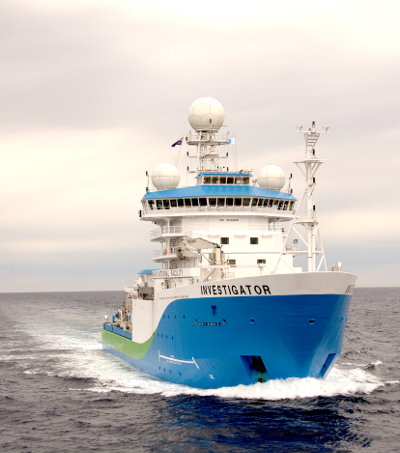Investigator sweeps new park
 Australia’s world-leading science vessel has returned from a voyage in Australia’s newest marine park.
Australia’s world-leading science vessel has returned from a voyage in Australia’s newest marine park.
Scientists onboard the research vessel (RV) Investigator, operated by CSIRO, have mapped the seafloor in Australia’s Cocos (Keeling) Islands Marine Park in detail for the first time.
The survey reveals massive flat-topped ancient sea-mountains, flanked by volcanic cones, snarly ridges, and canyons formed from avalanches of sand that have slumped down onto the abyssal ocean floor.
It also surveyed previously unknown deep-sea life in the Indian Ocean Territories.
On this 35-day, 11,000km journey, underwater video revealed diverse fish life hovering over the summits of the seamounts, samples of which have been collected from as deep as 5 kilometres below the surface.
Some of the most fascinating finds are:
-
A previously unknown blind eel collected from a depth of about 5 km covered in loose, transparent, gelatinous skin. Their eyes are poorly developed and, unusually for a fish, females give birth to live young.
-
Deep-sea batfishes that amble over the seafloor on their arm-like fins. They have a tiny “fishing lure” in a small hollow on their snout to attract prey.
-
The Tribute Spiderfish, with incredibly long lower fins with thickened tips, which allow it to prop high up off the bottom as if it was on stilts, giving it the perfect height to feed on small prawns that drift by in the current.
-
The bizarre Pelican Eel with a tiny head at the front of its enormous jaws, and an expandable stomach so that it can engulf and swallow large food items. Pelican eels are covered in black velvety skin and have a light organ on the tip of the tail to attract prey.
-
Highfin Lizard fish are voracious deep-sea predators with mouths full of long sharp teeth. They belong to a group of fishes that are simultaneous hermaphrodites; they have an ovotestis with functional male and female reproductive tissue at the same time.
-
The voracious Sloane’s Viperfish, with huge fang-like teeth that are visible even when the mouth is closed. Viperfish have rows of light organs along the underside and a very long upper fin with light organs on the tip to attract prey.
-
The Slender Snipe Eel, found as deep as 4 km below the sea surface. With its long thread-like tail, it can reach a metre in length while only weighing 50 grams. The curved jaws, which are permanently open, are covered in tiny hooked teeth that snag their crustacean prey.
-
Pancake sea urchins, which have a delicate skeleton that flattens like a pancake when it is out of the water. The spines are tipped with poison.
-
Pumice stones that are likely to be from the 1883 eruption of Krakatoa in Indonesia.
The team also produced detailed three-dimensional images of the massive mountain underneath the Cocos (Keeling) Islands themselves, which has never been mapped in detail before.
The Australian government proclaimed two massive marine parks across Australia’s Indian Ocean Territories in March 2022 that together cover an area almost the size of New South Wales.
The recent and future expeditions will supply scientific data that will help Parks Australia to manage these areas into the future.







 Print
Print